
If you want to create music with a computer, you will first need the appropriate software in order to turn your high-tech typewriter into a “digital audio workstation”, or DAW for short.
Early in the digital history, engineers designed synthesizers or effects but did not yet have the technology to make an audio recording on the computer. These first steps quickly led to design a communication language (now standard) called MIDI and which lead to the development of early sequencers.
Audio recording computer software were later developed and incorporated the MIDI sequencer, and effects. With Steinberg‘s VST technology, the world of digital audio were able to develop third-party software (called plug-ins) for effects or synths or drum machines that could be connected to the main audio/MIDI sequencer . The sequencer software is then called a “host”, since it supports a multitude of other software (there are thousands today!) And allows you to access an infinite number of sounds and sound characteristics.
Sequencer, DAW, recording software, whatever the name – you should be able to easily create music and have fun in the process!
PS: You can now easily download software licenses in our Thomann Download Store! without ha
Here is a brief overview of the most famous and important sequencers
Propellerhead Reason
Reason is unique and best suited for beginners – but it is of course not limited to novices! Like in a real “analog” studio, you can combine various types of (digital) equipment using an intuitive and attractive graphical interface that makes Reason one of the most user friendly DAWs available on the market.
Reason has a good selection of effects and instruments on board, however, the usual third-party plugin formats such as VST and AU aren’t directly supported. The synths and effects are all very good and, above all, resource-conserving. The selection concerning sampled instruments is also good, but not comparable to the major libraries such as Native Instruments, EastWest etc. Nevertheless, Reason is still an excellent DAW to take your first steps into the world of recording and producing material in a few easy steps.
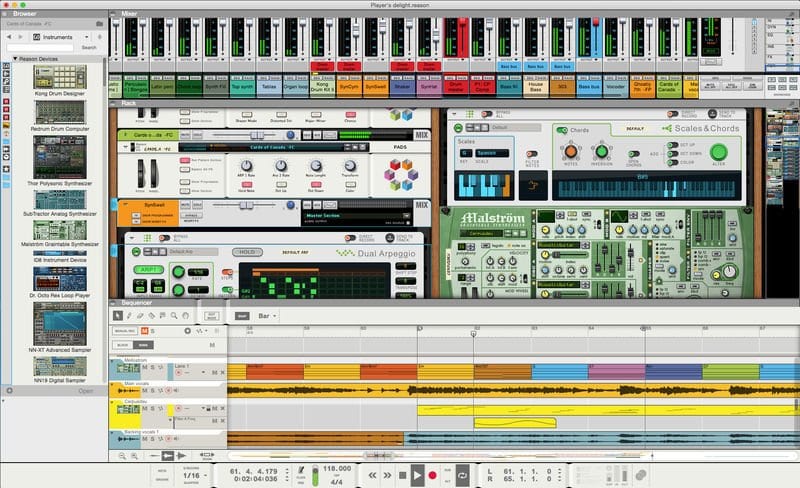
Propellerhead Reason
At one time it was not possible to record directly in Reason , when it was still purely as thought of as a sound generator. But those days are long gone and Reason is also very popular among self-recording singer-songwriters, largely due to the simple design of the arrange and mix window. In addition, there are loads of special effects such as amp simulations for guitarists and bassists.
Reason is a product suitable for all and highly recommended for those who want to produce music quickly and easily – but in handling very large audiovisual projects there are specifically optimized programs which are more suitable.
Fruity Loops aka FL Studio
Fruity Loops follows a similar concept as Reason, but with the possibility to operate VST plug-ins, and this allows you to expand the program as desired!
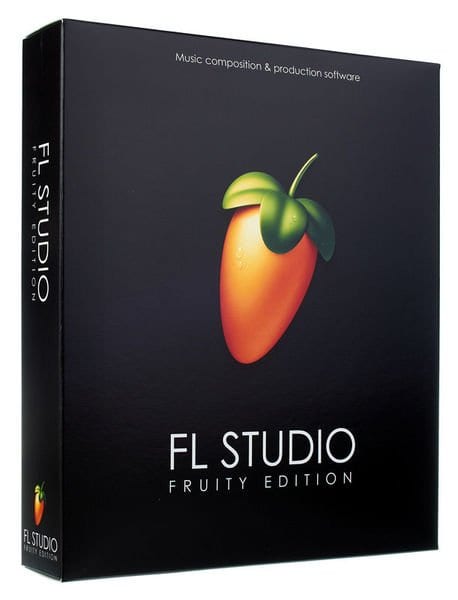
Fruity Loops aka FL Studio
Just like Reason, FL Studio comes from the field of original sound generators, but can now also produce more extensive audio recordings. It offers a variety of playful approaches, such as the pattern-based beat creation, which is very popular among modern music styles such as techno and hip-hop. Many successful producers swear by the compositional possibilities of “Fruity Loops“, which by its original name falsely conjures up very childlike associations.
FL Studio‘s FLI GUI is minimalist and kept sober, which significantly contributes to the result-oriented workflow of the software. The extreme ease of use, coupled with a concept of immediate composing and producing music and the ability to use their own plug-ins freely, make FL Studio a very good choice for any type of musician. Furthermore, lifetime free updates are also included!
Apple Logic
Logic has been part of Apple for quite some time and is only available for the macOS platform. It is still one of the most widely used DAWs, is one of the best all-rounders mastering the balancing act between a sober editing tool and a creative production tool. Basically there’s no restrictions and you can bring your project to a larger studio and expect support. Logic is also extremely complete and available at a very good price.
Logic, like Reason, and FL Studio, is rather a composition tool, ideal for creating MIDI arrangements, be it with plug-in instruments and/or hardware synthesizers instead of the typical recording program. The included instruments are progressive and provide ample inspiration. This is not to say that you cannot record, edit and mix with Logic. And with many small professional tools and advanced options, specialists like Pro Tools and Cubase will have to stand out and innovate!
AVID Pro Tools
Pro Tools is THE industry standard in large studios, which is mainly determined by the American market. Professional work is often assimilated with the presence of Pro Tools software. Beyond the historical context, the relevance of Pro Tools fades with increasingly competitive competition. Previously, having Pro Tools required specific hardware acceleration processing that, at the time of simple core processors, enabling huge professional projects with a large number of tracks and effects. Now only software performance is required and the supported plug-in interface is in AAX format.

Avid Pro Tools
One of the biggest advantages of such an, admittedly rather expensive, system, is still, the ability to record (even in tightly packed projects) without losing the possibility of listening in real time. The mixing of tracks, effects and virtual instruments is the finest and most detailed, thanks to the quality of its processing of the various plug-ins and the ability to compensate for this processing time.
In addition, the editing capabilities in Pro Tools are of the highest level because the program was designed specifically for these three purposes: recording, editing, mixing. The possibilities of creating sounds using virtual instruments were added quite late and is more of a nice addition rather than a basis.
The learning curve is very steep with Pro Tools, however, if you can get into it and master the appropriate keyboard shortcuts, you will surely belong among the fastest in audio processing.
Steinberg Cubase
Cubase has been a popular MIDI sequencer for over two decades. It is also a common middle ground between Logic’s great Composer capabilities and Pro Tools‘ processing. In recent years, Cubase has been able to gain a significant spot in the market, especially because the product and price policy of AVID (Pro Tools) is often prohibitive.
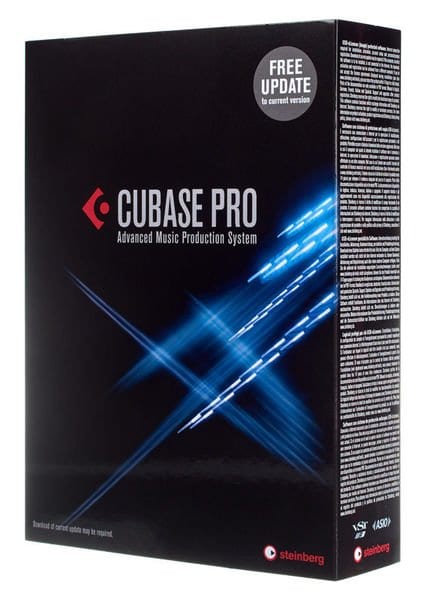
Steinberg Cubase Pro 9
Cubase is very powerful and offers a lot of configuration possibilities to customize the software to your own needs, because the various possible workflows are very different. Whether it’s record editing or computer-aided music composition, Cubase can do it all! The now very comprehensive software includes impressive virtual instruments that are very extensive and provide a very good foundation. Not as popular as Logic, but definitely more inspiring than Pro Tools. The Steinberg VST plug-ins are of course integrated into Cubase. In terms of editing, Pro Tools is often considered to be faster and less complicated with its direct access possibilities and sober look.
Ableton Live
Ableton Live is unorthodox, but is also a complete DAW especially popular for electronic artists, because of its peculiar characteristics. First of all there is its “non-stop” approach, which means it’s not required to stop the music during most operations and processing, and so you can continue to work without interrupting the creative process. Thanks to playback quantization, you can jump back and forth between individual parts of the arrangement without dropouts or tempo changes! The DAW is your instrument, so to speak.

Ableton Live
The clip matrix is another feature worth noting, an archive for audio samples, complete tracks, but also MIDI clips with assigned virtual instruments that lets you combine and play them at will. This way it is possible to create several variants of totally different arrangements among themselves to use in the studio and especially live, the context in which Ableton wins: backing tracks, different DAW modules, effects (basic but definitely usable) and several racks make it easy to handle. Furthermore, you can also use external VST and AU.
The GUI of Live is very clean, minimalist and completely free of the unnecessary. The tools are precise, but also somewhat limited: here, programs with the classic editing, such as Cubase, Pro Tools and Logic, once again take the lead.
Presonus Studio One
Studio One is a relatively young DAW – and as such brings a crucial advantage: the code is fresh, young, efficient and free from years and years of change. The developers were able to take advantage of the best aspects of existing DAWs and pack them into one program – and even improving them.
Presonus Studio One is a mix of very useful features, complex editing and ease of use. Despite the young age of the software, the team Presonus is not to be underestimated, as it is composed of old Cubase developers.
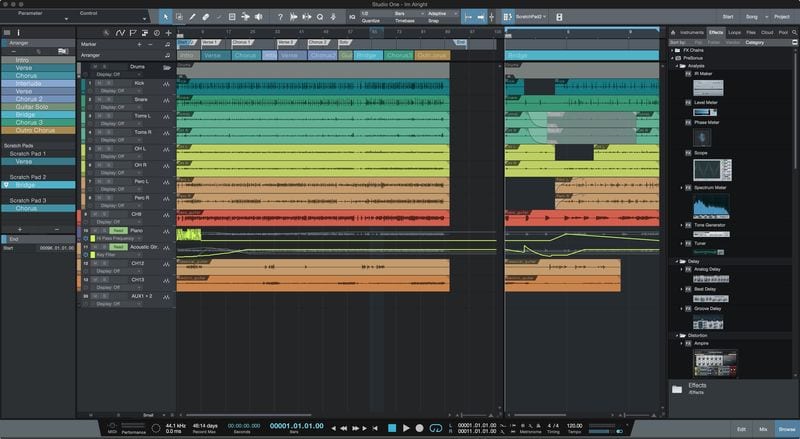
Presonus Studio One V3
Thanks to its wide use of drag and drop, this DAW is very workflow oriented and is extremely simplified. The “single window” philosophy, for example, allows more control, and songs are organized into “projects” which ultimately benefits the finalizing and mastering. The scratch pad feature offers the possibility to experiment with alternative arrangements without destroying the “original song” and, through the integration of Celemony Melodyne which is an incredibly good tool for pitch and intonation processing, which has established itself as the tool for vocal correction in addition to autotune. Studio One also has plenty effects and instruments on board.
Studio One is particularly suitable for newcomers – because seasoned players generally remain loyal to their first DAW. And in terms of the many ingenious details, extensive equipment and good value for money, Studio One is great choice.
Which do you personally swear by and why?
We look forward to your comments!
23 comments
Leave a Reply
You are currently viewing a placeholder content from Facebook. To access the actual content, click the button below. Please note that doing so will share data with third-party providers.
More InformationYou are currently viewing a placeholder content from Instagram. To access the actual content, click the button below. Please note that doing so will share data with third-party providers.
More InformationYou are currently viewing a placeholder content from X. To access the actual content, click the button below. Please note that doing so will share data with third-party providers.
More Information




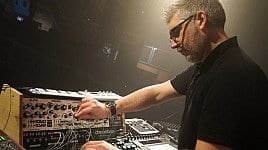
Niclas Gustafsson says:
I have been a Logic user since 2003 but last year i switched to Studio One 3. Couldnt be happier! There are a few bugs to iron out, but just as many as in Logic and Cubase. And the workflow and speed of operation is second to none. Presonus did really gather the best of them all. Pro tools color coding, cubase metering, logics ease and clean look. And then some! The first steps towards interlinking S1 with the scoring app Notion is promising, the ipad app with its macro system is wonderful, and the project/mastering side is just the best. That feature should have been standard in all daws 15 years ago! Its obvious and genious!
Jess Humphries says:
As usual you forgot Reaper!! It will do anything the big boys can do for waaaaaaay less money. Used it for live work, studio work and midi work – VST support and it’s never dropped out on me once.
kinimot says:
Ardour, anyone? Mixbus? Reaper?
Jostein Chr. Andersen says:
I prefer Harrison Mixbus32C, it is the workflow that attracts me. As most DAWs, it has everything one need for tracking, editing and of course mixing.
Joel says:
Studio One is fantastic but I genuinely argue that once you get your head around Logic you won’t want to use anything else. They’re doing a fantastic job of stealing, I mean uh, taking inspiration, from features in other DAWs (such as the smart tool in Pro Tools) and the workflow is absolutely unparalleled. Not to mention that the stock instruments and effects are amongst the best out there.
Amstrup says:
Reaper.
Jacek says:
Digital Performer
Unfortunaly nit mentioned above 🙁
Because every audio,/midi short elements I copied fix magically to płace I want to paste it 🙂
Martin T says:
Reaper is number one! For musicians by musicians, I’m using it for years and it only gets better.. great plugins included ,great workflow and you can customize it as you like and it runs like a charm and the pricetag is unbeatable! ?
Graham C. Williams says:
Samplitude ProX 3 + Some Waves and DMG audio plugins. First Class.
Darth Pena says:
For recording: Pro Tools
For mixing: Mixbus, Pro Tools
For composing: Digital Performer, Logic
For electronic music or virtual instrument based music creating (Piano roll): FLStudio, Logic, Reason, Sonar
For EDM: Live
For beginners: Mixcraft (and all DAW:s bundled with audio interface)
For anyone: Cubase, Reaper
bjorn says:
Reaper is as good as any high-priced DAW I have ever used, at a fraction of the price.
Harri says:
Cakewalk Sonar all the way.
It’s funny that it wasn’t mentioned, as alongside ProTools, Logic and Cubase it is one of the most commonly used “big” DAW:s these days.
Darude says:
> Totally agree. Sonar FTW!
Vesslan says:
Band in a Box anyone? xD
Warlock says:
+1 for surprise at Reaper being missed out. As for Cakewalk, I didn’t even know Cakewalk / Sonar was still made. I used to have keys that I bought but lost ’em when I stopped using it in favour of Reaper.
As has been said before, Reaper really is great for everything.
M says:
Renoise! ?
Phil says:
Reaper gets my vote as well. I have Pro Tools but never use it due to not being able to use VSTs. Used to use Logic before it was acquired by Apple and have used Cubase before as well. Cubase has tempted me to come back to it, but Reaper does everything I need.
Joerg Baermann says:
Cakewalk SONAR + Toontrack EZ Drummer & EZ Mix
Sam says:
Reaper is the way to go. It just works, easy to use UI & price tag is totally unbeatable,
Roseann says:
I do not even know how I ended up here, but I assumed this publish was great.
I don’t understand who you’re but certainly you are going to a well-known blogger
when you are not already. Cheers!
ffotballdrakter
Dorothy says:
I was able to find good information from your blog articles.
Bayern Munich fotbollströja
evey says:
Reaper Masterrace
hotel frankfurt-Oder says:
“Große enorme Dinge hier Ich bin sehr zufrieden, deinen Beitrag zu sehen. Vielen Dank und ich schaue voran, um dich zu berühren.”
http://messehotel-frankfurt-oder.de/